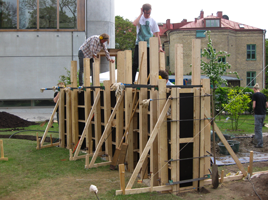





Rammed Earth Sculpture Garden is a collaboration with the artist Jane Philbrick at the Skissernas Museum in Lund, Sweden. To realize the project, we worked with the Lund University Department of Architecture, and the Botanical Garden of Lund. The installation formed the outdoor component of Philbrick's 2009 solo show at the Skissernas Museum.
After preliminary discussions with Philbrick at the Center for Advanced Visual Studies at MIT regarding the use and limitations of rammed earth, I travelled to Lund for two weeks during the spring of 2009 to provide design as project architect and led the students in construction of the installation.
The joint artistic and pedagogical goals made for a unique challenge. The finished installation functions as a part of an exhibition at a major museum in Sweden, so it was important that the piece to designed and constructed to the highest possible standard. At the same time, the project was an opportunity for the architecture students to explore a natural building material. It was also the first time many of the students had participated in a full-scale construction project. Added to the challenge was a schedule that left little room for error during the construction process.
Prior to my arrival, 35 first- and second-year architecture students divided into groups for an intensive week-long design charrette with Philbrick and rammed earth theorist Lars-Allan Palmgren in which they developed individual schemes for the installation. Following the presentation of the schemes by the students, Philbrick and I worked together to meld the proposals into one design that was technically and practically feasible while meeting the aesthetic criteria of the installation.
During the second week, we worked with students to develop the design and mock up individual components of the installation. Design ideas were discussed in review, reworked, developed at scale, reviewed again, and documented. The work included trips to the botanical garden to investigate available plant species from an aesthetic and practical standpoint. Students made test cylinders for compression testing, calculated the amount of soil and other materials that required by the project, arranged for material delivery, and the dozens of other tasks required for a site specific installation project.
The third week was devoted to construction. Students worked long hours at the site, building formwork, transporting earth, compacting it with pneumatic tools, stripping forms and resetting them. The formwork for the curved wall presented a special challenge. Work also moved forward in the woodshop at the School of architecture, preparing the trellis elements for installation after the completion of the rammed earth. The finished installation is a testament to the hard work and skill of the students,
Special thanks are due to Elisabet Haglund, Director of the Skissernas Museum, and Tomas Tagil, professor of architecture at Lund University, who coordinated the project.